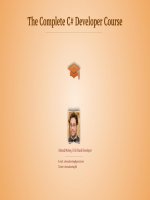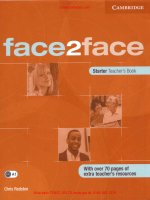093 chapter 05 tủ tài liệu training
Bạn đang xem bản rút gọn của tài liệu. Xem và tải ngay bản đầy đủ của tài liệu tại đây (14.48 MB, 43 trang )
The Complete C# Developer Course
Ahmad Mohey | Full Stack Developer
E-mail :
Twitter : ahmadmohey85
Object-oriented Programming Part 1
Ahmad Mohey | Full Stack Developer
E-mail :
Twitter : ahmadmohey85
Object-oriented Programming Part 2
Sealed classes
Ahmad Mohey | Full Stack Developer
E-mail :
Twitter : ahmadmohey85
Object-oriented Programming Part 2
Static classes
Ahmad Mohey | Full Stack Developer
E-mail :
Twitter : ahmadmohey85
Static classes
•You can only have static members.
•You cannot create an instance of it.
•They are sealed
Object-oriented Programming Part 2
Nested classes
Ahmad Mohey | Full Stack Developer
E-mail :
Twitter : ahmadmohey85
Object-oriented Programming Part 2
Partial classes
Ahmad Mohey | Full Stack Developer
E-mail :
Twitter : ahmadmohey85
Object-oriented Programming Part 2
Namespaces
Ahmad Mohey | Full Stack Developer
E-mail :
Twitter : ahmadmohey85
Object-oriented Programming Part 2
Struct
Ahmad Mohey | Full Stack Developer
E-mail :
Twitter : ahmadmohey85
Object-oriented Programming Part 2
Classes VS Structs
Ahmad Mohey | Full Stack Developer
E-mail :
Twitter : ahmadmohey85
Classes VS Structs
Class
Struct
✓ Declared with class keyword
✓ Declared with struct keyword
✓ Supports inheritance
✓ Doesn’t Support inheritance
✓ User-defined constructors can be implemented
✓ User-defined constructors can’t be implemented
✓ Data members can be initialized in the class
✓ Data members can’t be initialized in the struct
definition
✓ Reference type (Heap)
definition
✓ Value type (Stack)
The majority of types in a framework should be classes, but if instances of the type are small and
commonly short-lived or are commonly embedded in other objects define a struct.
Object-oriented Programming Part 2
Enumerations
Ahmad Mohey | Full Stack Developer
E-mail :
Twitter : ahmadmohey85
Object-oriented Programming Part 2
Country exercise
Ahmad Mohey | Full Stack Developer
E-mail :
Twitter : ahmadmohey85
Country Exercise
Country class
Child of a base class called world, and world class itself has couple of variables
called planet name and continent and properties to access these variables
Variables : country name, capital, languages , currency
Properties : Country name, Capital, Languages and Currency
Constructor : initialize country name and capital
Methods : two overloaded methods to display welcome message
Struct: To define the first and second language for each country
Enums : 3 different enums for the continents, currencies and languages
Country Exercise
Here is what is required (1 of 2):
1. Define namespace called WorldNamespace
2. Create a base class called World
3. Create non-accessible (outside class) variable called planetName
4. Define enumerations called Continents (with the continents names)
5. Create non-accessible (outside class) instance of enum Continents called Continents
6. Create a property to allow access to planetName and Continents
7. Define two more enums called Currencies and Languages
8. Define a child class called Country derived from World
9. Define non-accessible (outside class) four variables in class Country which are countryName, capital,
countryLanguages and currency
10. Define a struct called CountryLanguages which has two non-accessible (outside class) variables called
firstLanguage and secondLanguage and two properties called FirstLanguage and SecondLanguage to allow
access to firstLanguage and secondLanguage
Country Exercise
Here is what is required (2 of 2):
11. Create four properties in class Country named CountryName, Capital, CountryLanguages and Currencies to
give access to four variables countryName, capital, countryLanguages and currency
12. Create a constructor to initialize properties CountryName and Capital
13. Define two overloaded methods called SayHi (which says Hi) one with no arguments and the other with
one string arguments to mention the country
14. In the main method create two instances of Country class name them countryOneInstance and
countryTwoInstance
15. Create instance of the struct CountryLanguages called countryLanguages
16. Assign two different languages using Languages enum
17. Assign the instance countryLanguages to countryOneInstance.CountryLanguages
18. Set planetName to “earth” and countryName to “any country”
19. Set Currency and Continents to corresponding enums values
20. Call SayHi methods and display values of countryOneInstance
Object-oriented Programming Part 2
Country exercise solution
Ahmad Mohey | Full Stack Developer
E-mail :
Twitter : ahmadmohey85
Object-oriented Programming Part 2
this keyword
Ahmad Mohey | Full Stack Developer
E-mail :
Twitter : ahmadmohey85
Object-oriented Programming Part 2
Interfaces
Ahmad Mohey | Full Stack Developer
E-mail :
Twitter : ahmadmohey85
Interfaces
An interface contains definitions for a group of related
functionalities that a class or a struct can implement.
Think of it as contract that all the classes inheriting the interface
should follow. The interface defines the 'what' part of the contract
and the deriving classes define the 'how' part of the contract.
Object-oriented Programming Part 2
Interfaces VS Abstract Classes
Ahmad Mohey | Full Stack Developer
E-mail :
Twitter : ahmadmohey85
Interfaces VS Abstract Classes
Interface
Abstract Class
Similarities
‣ Can't be instantiated directly
‣ Must implement all its members
‣ Can contain events, methods, and properties.
Differences
‣ Can’t have method implementations
‣ Can have method implementations
‣ Allow multiple inheritance
‣ Doesn’t allow multiple inheritance
‣ Can’t have access modifiers, everything is public
‣ Can contain access modifiers
‣ Can’t contain variables
‣ Can contain variables
Object-oriented Programming Part 2
Exception Handling
Ahmad Mohey | Full Stack Developer
E-mail :
Twitter : ahmadmohey85
Exception Handling
An exception is a runtime error that happens during the execution
of a program.
Exceptions provide a way to transfer control from one part of a
program to another.
Exception Handling
Exception handling is built upon these keywords: try, catch and finally
Try: try block contains a block of code, exceptions is expected to happen if we
run it.
Catch: program catches an exception with an exception handler at the place in
a program where you want to handle the problem.
Finally: finally block is used to execute a block of code, whether an exception is
thrown or not thrown.









